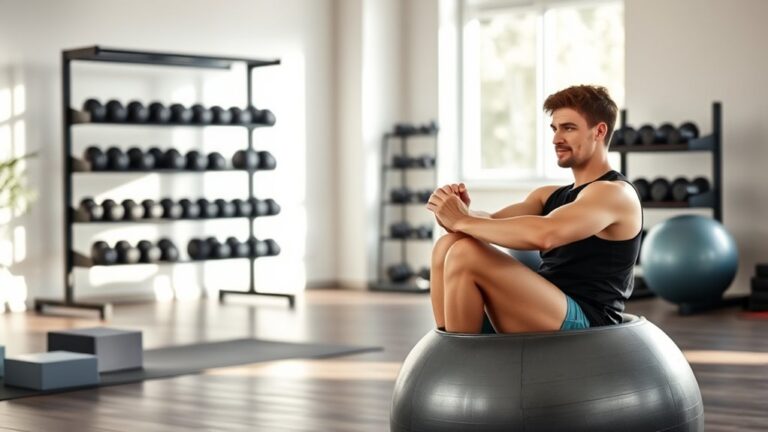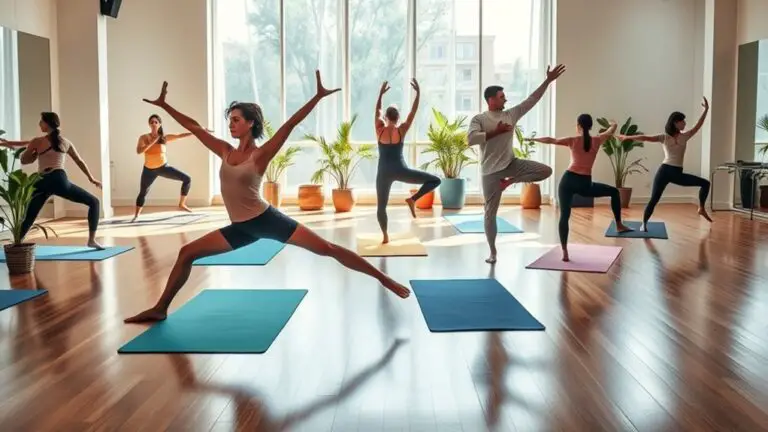The Best Gym Exercises to Relieve Muscle Tightness
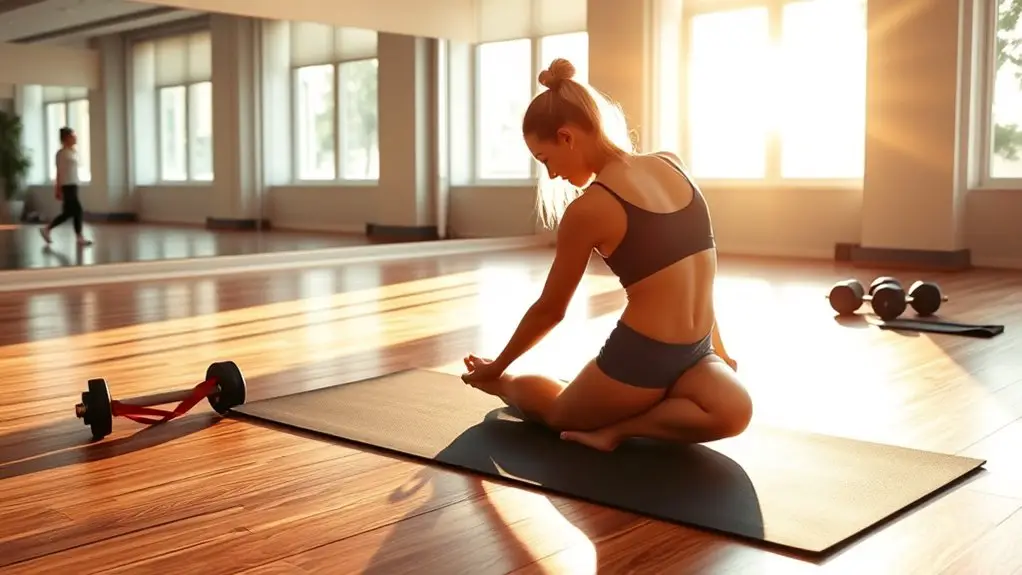
To relieve muscle tightness, incorporate dynamic stretches like lunges and high knees as part of your warm-up. Targeted stretches, such as hamstring and hip flexor stretches, ease tension. Also, foam rolling can considerably alleviate soreness and improve circulation. Don’t forget to cool down with gentle stretches and light walking post-workout to enhance recovery. A well-rounded routine combining these elements will improve flexibility and performance. Keep going, and you’ll discover even more effective techniques to enhance your workout experience.
Understanding Muscle Tightness
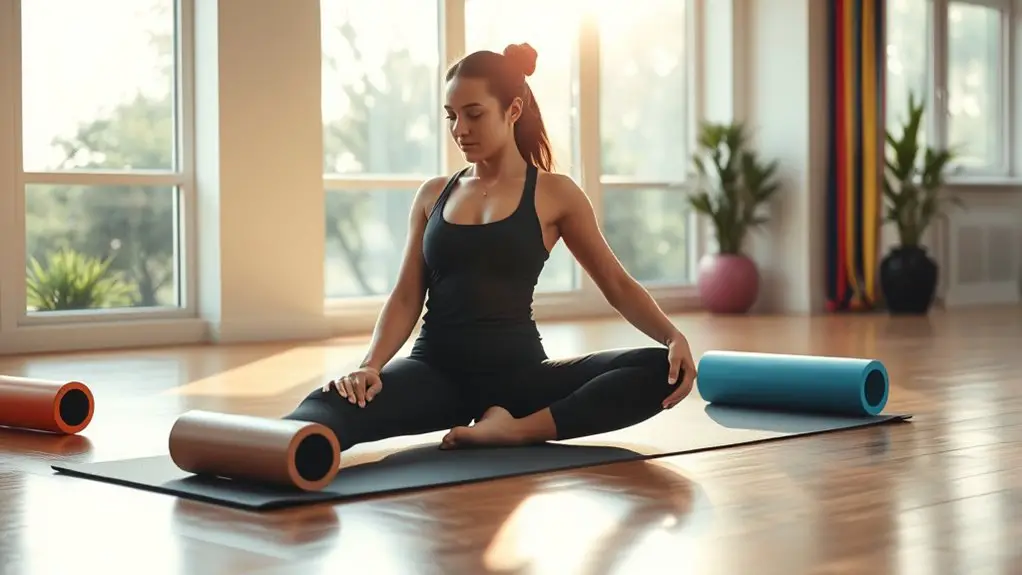
Muscle tightness is a common issue that many people face, often stemming from factors like stress, inactivity, or intense workouts. Understanding muscle anatomy is vital for tackling this problem. Your muscles consist of fibers that contract and relax; when they’re overworked or underutilized, they can become tight and painful.
Tightness causes can vary, but frequently, it’s due to poor posture, repetitive movements, or lack of flexibility. You may notice this tightness in specific muscle groups, like the neck, back, or legs, which can hinder your performance and overall well-being. Lower back pain can also arise from activities that put strain on your muscles, such as skipping rope or improper lifting techniques.
Recognizing the underlying factors contributing to your muscle tightness is the first step towards relief. By being mindful of your body mechanics and making small adjustments, you can start to alleviate discomfort. Remember, it’s essential to listen to your body and address tightness before it leads to more significant issues. Stay proactive, and you’ll feel the difference!
Importance of Stretching
Stretching is essential for enhancing your flexibility and mobility, making it easier to tackle your workouts. By incorporating regular stretches, you can greatly reduce your risk of injury and pain, allowing you to stay active and perform at your best. Remember, a few minutes of stretching can make all the difference in your fitness journey.
Enhances Flexibility and Mobility
While you may focus on strength training, incorporating flexibility and mobility exercises is equally crucial for overall fitness. Enhancing your flexibility and mobility can improve your performance in workouts and daily activities. By regularly practicing flexibility routines, you can increase your range of motion, making movements feel smoother and more efficient. Mobility drills are essential for targeting specific joints and muscle groups, helping to release tightness and improve overall body function. Dedicate time each week to these exercises, and you’ll notice significant improvements in how your body feels and moves. Remember, flexibility and mobility aren’t just about stretching; they’re key components to achieving a balanced, strong, and resilient body. Make them a priority in your fitness journey!
Prevents Injury and Pain
Incorporating flexibility and mobility work not only enhances your performance but also plays an essential role in preventing injury and pain. When you stretch regularly, you’re improving blood flow to your muscles, which aids recovery and reduces stiffness. This not only promotes injury prevention but also guarantees you’re better prepared for intense workouts. Stretching helps maintain joint health and increases your range of motion, allowing you to perform exercises more effectively. Additionally, it’s a key component of pain management; alleviating tightness can markedly reduce discomfort during and after your workouts. By prioritizing stretching in your routine, you’re investing in your overall fitness and well-being, ensuring you stay active, healthy, and pain-free for years to come.
Foam Rolling Techniques
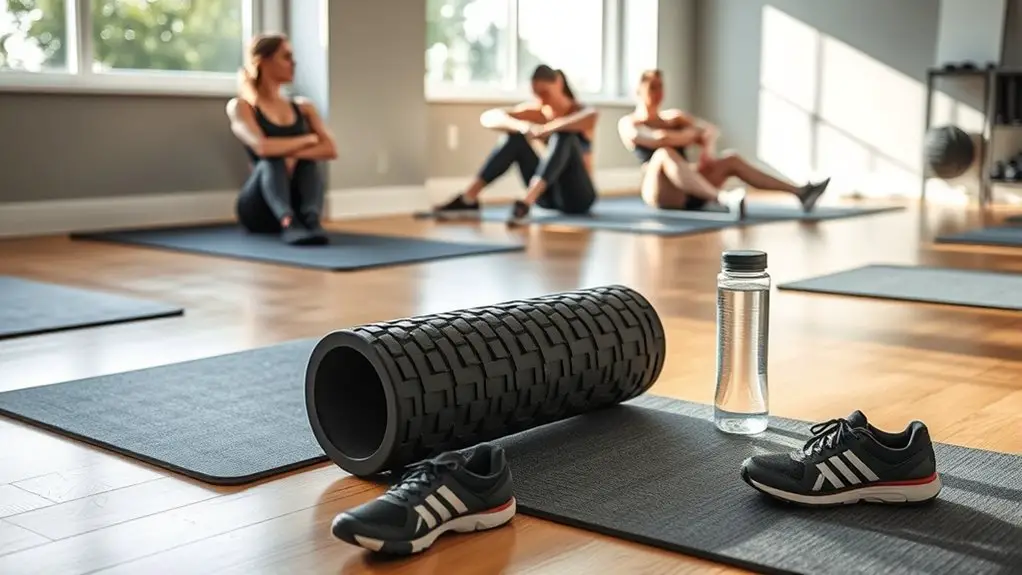
Foam rolling is an effective way to relieve muscle tightness and enhance your overall workout performance. By using foam roller techniques, you can incorporate self myofascial release into your routine, helping to alleviate tension and improve mobility.
Here are three essential foam rolling techniques to try:
- Quadriceps Roll: Lie face down and roll your quadriceps, focusing on any tight spots.
- Upper Back Roll: Place the foam roller under your upper back and gently roll side to side, targeting any knots.
- Calf Roll: Sit with one leg extended and the foam roller under your calf. Roll from the ankle to the knee for maximum relief.
Incorporating these techniques into your routine not only helps reduce muscle tightness but also prepares your body for peak performance. So grab your foam roller and get rolling—you’ll feel the difference!
Dynamic Warm-Up Exercises
Before you jump into your workout, don’t underestimate the power of a solid dynamic warm-up. These exercises not only prepare your muscles for action but also help prevent injuries and improve performance. Let’s explore some effective techniques to get your body moving and ready to tackle those tight muscles.
Importance of Dynamic Warm-Ups
Many people underestimate the significance of dynamic warm-ups, but they’re essential for preparing your body for a workout. These dynamic stretches not only enhance your performance but also reduce the risk of injury. By incorporating a proper warm-up, you’ll experience multiple warm up benefits that can transform your exercise routine.
- Increased blood flow to muscles
- Improved flexibility and range of motion
- Enhanced coordination and balance
Effective Warm-Up Techniques
Although you might be keen to dive straight into your workout, incorporating effective warm-up techniques is essential for optimizing your performance and preventing injury. Start with dynamic stretches like leg swings and arm circles to enhance joint mobility and prepare your muscles for action. Incorporate movements that mimic your workout, such as lunges or high knees, to engage your body fully. This isn’t just about getting warm; it’s active recovery for your muscles, improving blood flow and flexibility. Aim for at least 5-10 minutes of these exercises before you lift or sprint. You’ll feel more energized, and your body will thank you for it, reducing the risk of tightness and injury during your session.
Targeted Stretching Movements
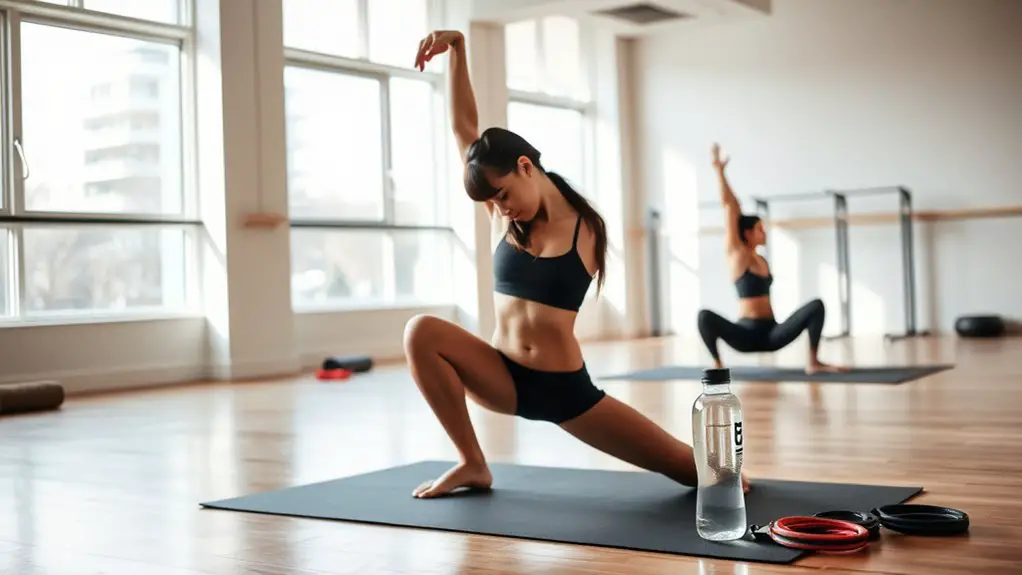
As you work to alleviate muscle tightness, incorporating targeted stretching movements into your routine can make a significant difference. These targeted stretches focus on specific muscle groups, promoting flexibility and relieving tension. Here are a few effective ones to include:
Incorporating targeted stretches into your routine can greatly enhance flexibility and relieve muscle tension.
- Hamstring Stretch: Sit on the ground, extend one leg, and reach towards your toes to loosen tight hamstrings.
- Chest Opener: Stand tall, clasp your hands behind your back, and gently pull your arms to open up the chest and shoulders.
- Hip Flexor Stretch: Lunge forward with one leg while keeping the other knee on the ground to stretch the hip flexors.
Strengthening Exercises for Flexibility
To enhance flexibility while building strength, it’s essential to incorporate exercises that engage multiple muscle groups and promote a fuller range of motion. Strength training isn’t just about lifting heavy weights; it’s also about using your body effectively to improve flexibility. Start with compound movements like squats and lunges, which not only build muscle but also stretch your hips and legs.
Add flexibility drills such as dynamic stretches before your workouts. Incorporating exercises like the inchworm or leg swings can enhance your range of motion and prepare your muscles for more intense strength training. Consider integrating resistance bands into your routine. They’re fantastic for both strength and flexibility, allowing you to perform controlled movements that challenge your muscles while encouraging stretch. By focusing on these strengthening exercises, you’ll notice improved flexibility, reduced muscle tightness, and better overall performance in your fitness journey. Additionally, activities like jumping rope can effectively improve coordination and balance, further complementing your flexibility and strength training efforts.
Yoga Poses for Muscle Relief
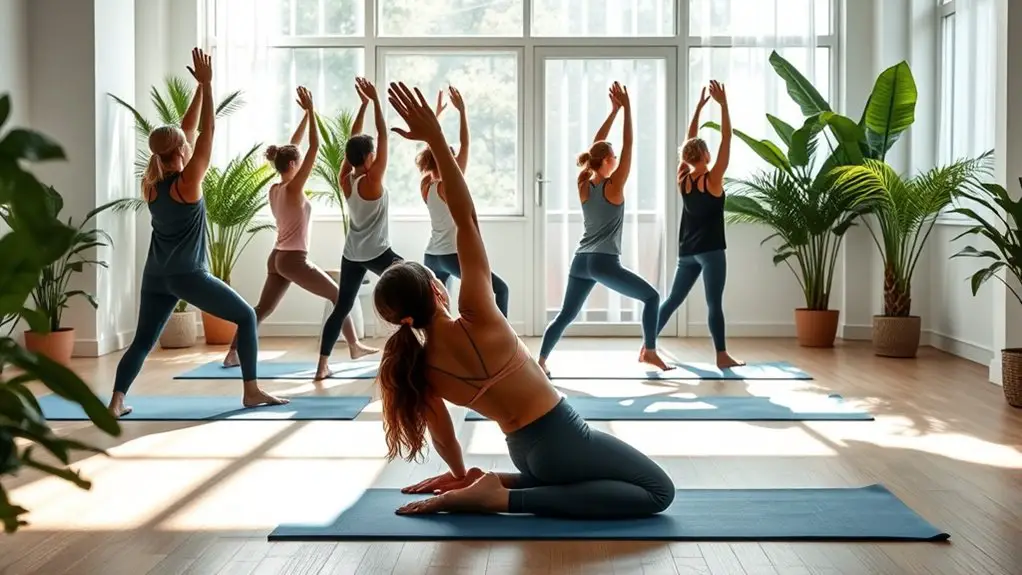
When you’re feeling muscle tightness, incorporating yoga poses into your routine can be incredibly beneficial for relief and recovery. Not only do these restorative poses help alleviate discomfort, but they also enhance flexibility and promote overall well-being.
Here are three effective poses to try:
- Child’s Pose: This gentle stretch helps release tension in your back and shoulders, promoting relaxation.
- Downward-Facing Dog: A great full-body stretch, it targets tight hamstrings and calves while invigorating your mind.
- Reclining Bound Angle Pose: Perfect for opening up the hips, this pose encourages deep breathing and relaxation.
Cool Down and Recovery Practices
Incorporating effective cool down and recovery practices into your fitness routine can greatly enhance your overall performance and well-being. After an intense workout, it’s essential to implement cool down techniques, such as gentle stretching or light walking, to lower your heart rate gradually. This helps prevent stiffness and promotes flexibility.
Additionally, consider recovery strategies like foam rolling or using a massage ball to target tight muscles, which can alleviate soreness and improve circulation. Hydration plays a significant role, too—so replenish fluids lost during exercise to support muscle recovery.
Don’t overlook the importance of rest as well; your muscles need time to repair and grow stronger. Aim for quality sleep and consider incorporating rest days into your routine. Remember, a well-planned cool down and recovery phase can make all the difference in how you feel and perform in your next workout. Stay committed, and your body will thank you!
Creating a Balanced Workout Routine
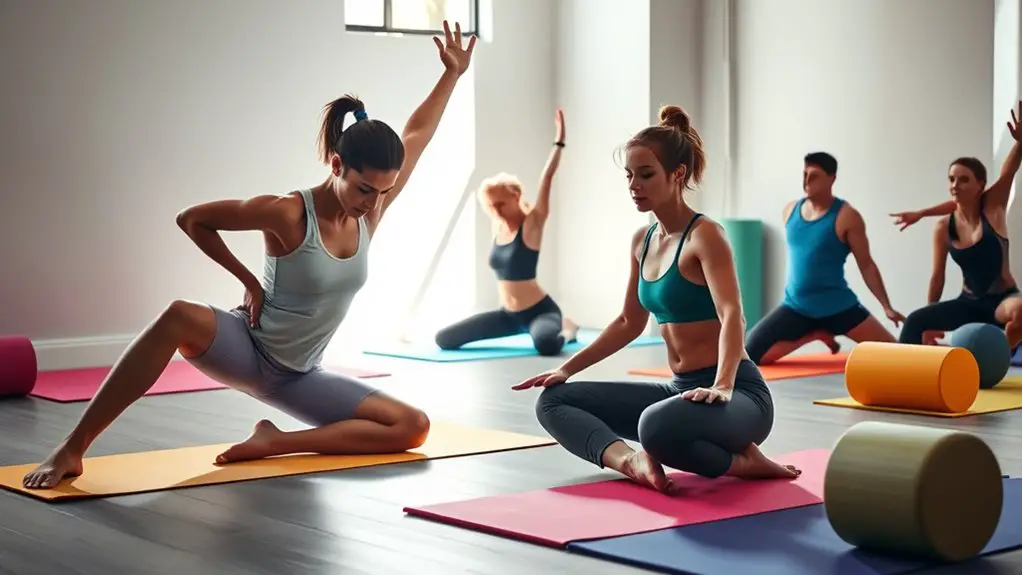
Creating a balanced workout routine is essential for achieving your fitness goals and maintaining overall health. To maximize your results, you need to incorporate both strength training and cardio integration. This balance helps you build muscle while improving endurance, ensuring you feel great and function well in daily life.
A balanced workout routine combines strength training and cardio for optimal fitness and overall well-being.
Consider these key elements for your routine:
- Balanced Strength: Aim for a mix of upper and lower body exercises, ensuring you target all major muscle groups.
- Cardio Integration: Include various forms of cardio, like running, cycling, or swimming, to enhance cardiovascular fitness and burn calories.
- Flexibility and Recovery: Don’t forget to add stretching and recovery sessions to maintain muscle elasticity and prevent tightness. Additionally, focusing on higher intensity exercises can prolong the muscle pump effect, enhancing overall performance and recovery.
Frequently Asked Questions
How Often Should I Perform These Exercises for Best Results?
Imagine your body as a garden. To flourish, it needs regular tending. For best results, you should perform these exercises at least three to four times a week. Think of this as your frequency guidelines; consistency is key. If you follow an ideal schedule, you’ll cultivate strength and flexibility, allowing your muscles to bloom. So, commit to your routine, and watch as your body transforms into a vibrant landscape of health and wellness.
Can I Do These Exercises at Home?
Absolutely, you can do these exercises at home! A home workout can be just as effective as a gym session. Just remember to incorporate exercise modifications that suit your space and equipment availability. Use bodyweight exercises or household items like water bottles for resistance. Staying consistent with your routine will help you achieve your goals. So, roll out that mat, get motivated, and enjoy a fantastic workout right in your living room!
What Should I Wear While Exercising for Muscle Relief?
When you’re exercising for muscle relief, it’s crucial to wear comfortable clothing that allows for free movement. Look for breathable fabrics that wick away sweat to keep you cool. Supportive footwear is just as important; it provides stability and helps prevent injury while you work on relieving tightness. Remember, feeling good in what you wear can enhance your motivation and overall experience, so choose wisely to enjoy your workout!
Are There Any Risks With These Exercises?
When you engage in exercises, think of it as dancing with your body—every move should flow gracefully. However, there are risks if you don’t prioritize injury prevention. Without proper form, you might strain muscles or joints, leading to setbacks in your journey. So, stay mindful of your technique, listen to your body, and don’t rush. Embrace the rhythm of your workout, and you’ll reap the benefits while minimizing risks. Keep pushing forward!
How Do I Know if Muscle Tightness Is Serious?
To determine if your muscle tightness is serious, focus on symptom assessment. If you experience persistent pain, swelling, or restricted movement, these could be injury indicators. Pay attention to any sharp or worsening discomfort that doesn’t improve with rest or stretches. Listen to your body; it’s your best guide. If you’re unsure, consulting a healthcare professional can provide clarity and help prevent further injury. Stay proactive about your health!
